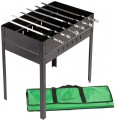Wall thickness
The thickness of the furnace walls.
This parameter is relevant primarily for solid fuel models (see “Fuel (source)”), and its general meaning directly depends on the type of product (see above), more precisely, on the material of the furnace. So, for barbecues, charcoal grills and other devices with metal fireboxes, the overall reliability and durability of the structure depends primarily on the wall thickness. At the same time, a value of up to 1 mm is considered very limited; it can be found mainly in low-cost models designed for occasional use. 1 – 2 mm can be called an average, and a thickness of 3 mm or more is already suitable for intensive daily use.
In turn, in ceramic grills and tandoors, the wall thickness is already measured in tens of millimetres; in the first case, it is usually about 18 – 20 mm, in the second — from 50 mm and more. Both there and there, thick walls serve to effectively accumulate and retain heat; accordingly, the greater the thickness, the better the product handles with these tasks.
Anyway, note that thicker (and, accordingly, more reliable and efficient) walls inevitably turn out to be heavier and more expensive.
Weight
The total weight of the product, taking into account the main elements of equipment (lids, canopy, food stands, etc.), but excluding fuel.
It is worth evaluating this indicator taking into account the type of device. So, the most compact barbecues and barbecue grills can weigh
4-6 kg or even
less(in camping barbecues, the weight does not exceed these values at all);
7 – 10 kg for such models is considered an average, and larger values \u200b\u200bare typical mainly for large stationary structures of high capacity. But ceramic grills and tandoors are, by definition, massive: in the first case, even in the lightest models, the weight
exceeds 10 kg, in the second it is usually
more than 50 kg.
Anyway, note that both small and significant weight have their advantages. So, with similar functionality, a lighter device will be more convenient to transport, but this convenience will have to be paid for by reducing the height (which affects convenience), reducing the capacity and/or thinner walls of the furnace (which reduces reliability for metal walls, worsens for ceramic ones). efficiency). Conversely, a heavier structure will be more reliable, durable, often more spacious, but at the same time less convenient when moving from place to place, and often more cumbersome.

